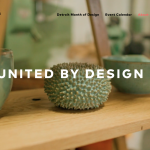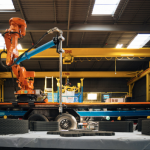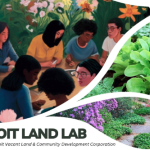Detroitisit spoke with Kiana Wenzell, co-executive director of Design Core Detroit and director of Detroit Month of Design about this year’s theme – United By Design – and how it plays out in the city every day.
Q: How has the Month of Design evolved over the years?
Wenzell: The first Detroit Design Festival occurred in 2011 and focused on independent designers. Since then, the festival has become a platform that uplifts the city’s independent designers as well as nonprofit organizations, individuals and companies of all sizes. The festival has grown from one week to an entire month and attracts attendees and brands from all over the world to partner and view the work of Detroit talent.
Q: This year’s theme is United by Design. What does that mean?
Wenzell: The Detroit Month of Design aims to highlight Detroit’s rich history and cultural landscape, as well as the potential for design to maximize social impact, uplift communities and contribute to the city’s economic growth. The design of a product, service or system can impact our lives for better or worse.

DETROIT MONTH OF DESIGN
This year Design Core is focused on how design unites our communities. We are highlighting interdependence and collaboration and how these two elements can help lead to design solutions that are more accessible and equitable for everyone. Detroit is a place where you can design, engineer, manufacture and mass market a product but it takes collaboration from a wide range of people. We are united in what we produce.
Q: How do you think the city is in fact “United by Design’
Wenzell: Detroit residents have always relied on each other to find solutions for their communities. Now, more than ever, we are experiencing a shift in creative industries towards interdisciplinary teams and collaboration. This is amplified through this year’s theme.
Q: How are communities involved and integrated within Month of Design?
Wenzell: A key part of Design Core’s mission is to empower Detroit’s design heritage and creative economy. The festival is a platform for connecting designers with each other, with new audiences and for engaging with the broader design communities. The festival also supports building pipelines to inspire and prepare the next generation of Detroiters for careers in creative industries.
The festival creates an opportunity for residents and business owners to learn about how they can embrace creative tools as a method for positively impacting the world around them. We aim to create a community in which residents, business owners, policymakers, and emerging designers can strengthen their skills, exchange ideas and innovate.
The Detroit Month of Design is co-created with the community through an open call. Every spring, Design Core hosts an open call for creatives to participate in the festival. We recruit a curatorial committee to help us select the events that will be included in the schedule. The events on the calendar represent an array of independent voices and reflect what is occurring in our creative community at this moment in time. Out of the 75+ events occurring this year, Design Core only produces five of them. The remaining events are produced by independent event organizers.
Q: Talk about Detroit being a “Global Leader in Inclusive Design.”

ROBOT HIGH FIVE
Wenzell: Inclusive Design is about considering the full spectrum of society when making design decisions and going through the creative process. We promote working hand-in-hand with residents, the government, and the business community to create solutions that are more sustainable and just. The vision is for Detroit’s design community to work hand-in-hand with residents and stakeholders to positively influence existing efforts that address equity in the city and beyond. This direction reflects a major shift in the practice of design from a focus on developing internally within the studio to mobilizing the collective power of community, external advocacy, and infusing broader community development efforts.
One example is the event, Robot High Five!, Presented by Citizen Robotics. This event offers the opportunity to experience 3D printing on a large scale and engage with designers to discover how they utilize robotics and automation in home building in order to provide affordable, sustainable housing and ease the worker shortage. Affordable housing is something that impacts everyone, and this is an example of how Detroit designers are addressing the issue through a creative lens.
Another example is the Design Jam, Presented by Design Core Detroit. The Design Jam is a two-day challenge for those interested in developing new product concepts that push the boundaries of adaptive active apparel and accessories for the limb loss community. At some point in their life, a lot of people will be either permanently or temporarily disabled or be the caretaker of someone disabled. The Design Jam is a way for designers to engage on an interdisciplinary team to prototype an issue that impacts millions of people in a way that doesn’t make it seem like an afterthought.
Q: How have design and the opportunities for designers evolved in Detroit over the last 13 years?
Wenzell: Over the last 13 years, there has been an uptick in demand for design services. Design industries continue to be significant employers and economic engines in Detroit, employing thousands of individuals and generating billions of dollars in wages. In order to continue growth we must make sure that people interested in design find resources and learning + job opportunities. The festival helps to get the word out about all of these things.
Q: What about design when it comes to Place Making?
Wenzell: A good example is East Ferry Warren. Like other Detroit neighborhoods, the East Ferry Warren neighborhood experienced population loss and disinvestment by the public and private sectors over the last 30 years. Disinvestment left residents feeling frustrated and seeking to create a community transformation of their own. The projects included in the East Ferry panel and walking tour are the result of a community-driven, neighborhood green space vision developed and implemented by East Ferry Warren residents and non-profits in partnership with Detroit Future City.
Attendees of the East Ferry event can listen to a panel discussion at Hunt Street Station featuring local, community-based land leaders from Oakland Avenue Farms and the Bailey Park Neighborhood Development Corporation alongside local planners. The speakers will share insights into the process of designing an inclusive, community-driven land use vision, along with the challenges and successes faced by the community as they make the plan a reality. Afterward, attendees can join the tour.
Events like this are important because we often need examples and models for local community-based development. We also need spaces for exchanging ideas and discussing how to navigate challenges.
Q: What other place-making examples in the city are showcased in Month of Design?

DETROIT LAND LAB
Wenzell: Detroit Land Lab – Presented by Detroit Vacant Land CDC in collaboration with the University of Michigan’s School of Environment and Sustainability, this community empowerment workshop is dedicated to sustainable creative land use and landscape design. The session will feature experts including landscape designers, land use advocates, and resident land stewards that have led successful landscape design projects in Detroit including Detroit Black Farmers Land Fund, Keep Growing Detroit, and the Detroit Land Bank Authority.
Another is Activating Our Collective Imagination with Designing Justice + Designing Spaces. Designing Justice + Designing Spaces (DJDS) is leading a community-driven development located at West Grand River Avenue and 14th Street. Their long-term vision, which emerged from four years of engagement with justice-based organizations and neighborhood stakeholders, is to build a social justice campus – an economically, environmentally, and socially sustainable oasis providing access to resources communities need to thrive.
Q: What is the future of Month of Design?
Wenzell: Each edition of the Detroit Month of Design is a reflection of our creative community at a specific moment in time. Next year’s festival will be different because we will be different. Each year, we build on what we learned in prior iterations, molding, shifting, and innovating in response to the changing world and community around us.
Q: What do you think is the future of design in Detroit?
Wenzell: The future of design in Detroit is filled with advanced technologies and a deep respect for human-centered practices and nature. What happens in Detroit, happens in the world.
As always, be sure to subscribe to our newsletter for regular updates on all things Detroit.























